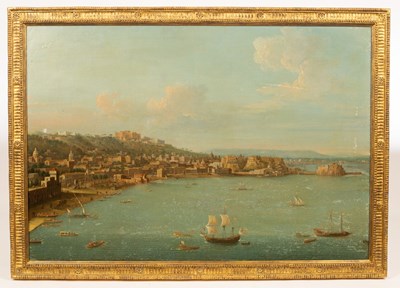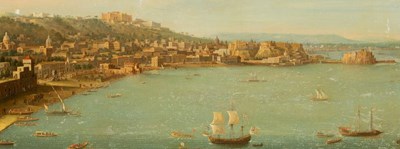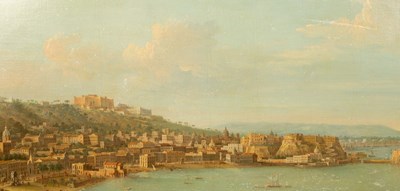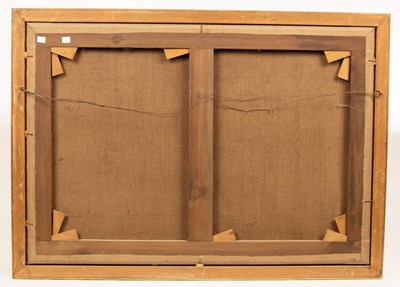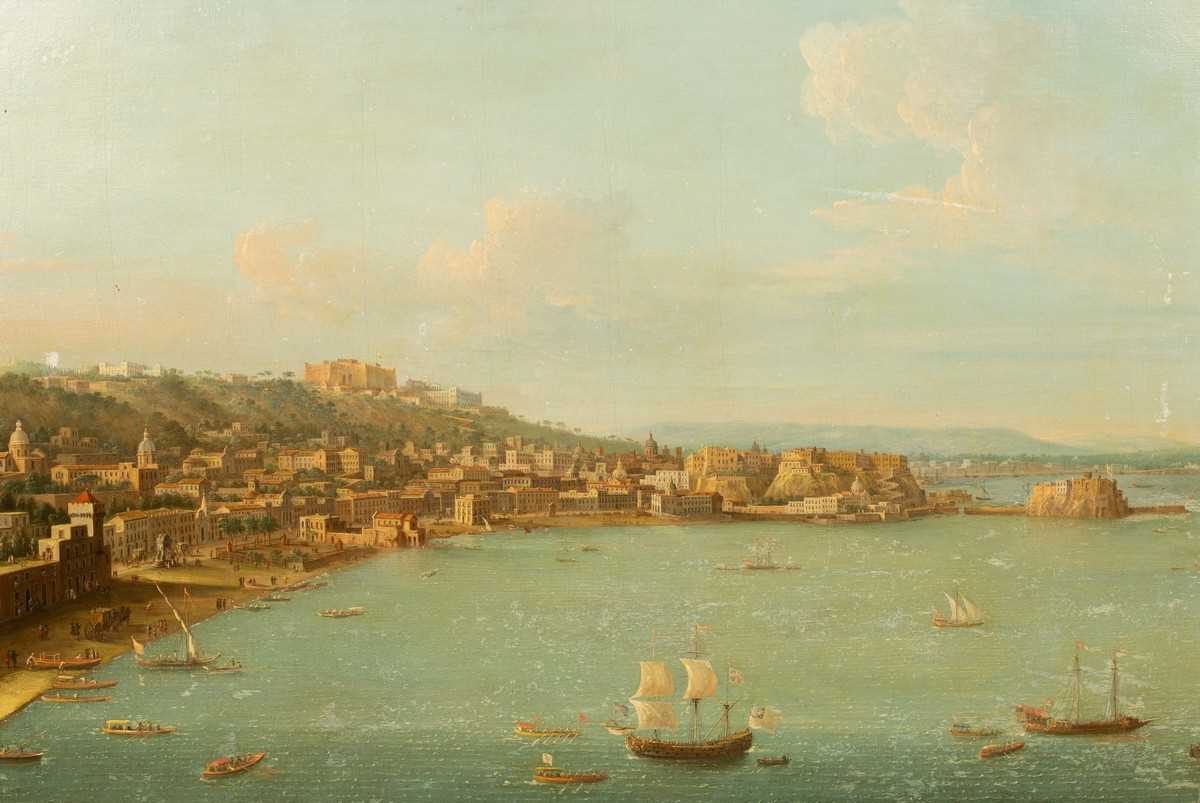27th Jun, 2023 10:00
Fine Jewellery & Old Master Paintings
333
Antonio Joli (1700-1777)/A View of Naples from Mergellina/oil on canvas, 67.5cm x 97.8cm/Note: In the eighteenth Century Naples was one of the great cities of Europe,'In size and number of inhabitants she ranks as the third city of Europe, and from her situation and superb show may justly be considered as the Queen of the Mediterranean' wrote john Chetwode Eustace in 1813. By then Naples had enjoyed a golden age of nearly eighty years as the royal capital of the richest Italian state. The reign, from 1734, of Charles VII, first of the Neapolitan Bourbon rulers of the Kingdom of the Two Sicilies (he was also, from 1759, King Charles III of Spain) saw the construction of the Teatro San Carlo and the palaces of Caserta, Portici and Capodimonte (which now houses the famous art gallery), the rediscovery of Pompeii and Herculaneum and the founding of the Naples Archaeological Museum. Music and painting flourished, and those travellers who extended their Grand Tour beyond Rome were amply rewarded by the experience. Residents including Sir William and Lady Hamilton greeted visitors such as the Holy Roman Emperor Joseph II, Casanova, Mozart, Angelica Kauffman, Joseph Wright of Derby, Jacques-Louis David, Elizabeth Vigée-Lebrun (who described the city as a 'lanterne magique ravisssante') and Goethe (who remarked that nobody who had seen Naples could ever be really unhappy).The definitive portrait of Naples in its heyday is that provided by Antonio Joli, whose depictions of the city over several decades make him to Naples what his (almost exact) contemporary Canaletto was to Venice. Joli was not, in fact, Neapolitan by birth. Most of the leading Neapolitan view painters were from elsewhere. Born in Modena, Joli was partly trained in Rome, where he worked until 1725 under Giovanni Paolo Panini (1691-1765), the outstanding Rome based view painter of his generation. During the following three decades Joli became the most widely travelled of the Italian view painters of the eighteenth Century, designing scenography as well as view painting throughout his career. It is as a scenographer that Joli is first recorded, in 1732, in Venice where he remained until after 1740. He is mentioned in the memoirs of Giacomo Casanova as 'the celebrated theatrical scene painter' (G. Casanova, History of My Life, ed. Baltimore & London, 1997, I, p. 200). Joli may have visited Dresden before productive periods in London 1744-1749 and in Madrid 1749-1754. After returning to Venice, where he became a founder-member of the Venetian Academy of Fine Arts, he embarked in 1756 on a tour of Southern Italy and Sicily with his most important patron John Montagu, Lord Brudenell (1735-1770), for whom he executed an unrivalled series of at least thirty-eight views of Southern Italy, Florence, Sicily, Malta and Southern France. These include his celebrated group of views of Naples, where he is first recorded on 21 April 1759 (R. Toledano, Antonio Joli, Turin, 2006, nos. N.VI.7, N.VIII-XIV, N.XIX.1, N.XX.1, N.XXIV and N.XXVII.6-7, all illustrated). Apart from a brief return to Venice, where he is recorded on 28 December 1761, Joli was resident thereafter in Naples, working for visitors and for fellow residents such as Sir William Hamilton. Joli must have been familiar with Naples long before this date. He is indeed described as 'Napoletano' in inventories of the collection of the great Venetian collector Field Marshal Johann Matthias von der Schulenburg, who paid him for a view of Naples in 1736, one of the first records of the artist as a painter of views (Toledano, op. cit., p. 298, no. N.I.1, illustrated). It is the setting of Naples in its glorious bay, in the shadow of Vesuvius, which gives it its unique character. The heart of the city is here seen from the West. Near the left edge is the Torretta of Chiaia or of Piedigrotta, built in 1564 as a defence against Turkish raids. Just beyond it is one of the fountains erected along the shore between the Castel dell'Ovo and Posillipo by Luís de la Cerda Fernández de Córdoba Folch de Cardona y Aragón, 9th Duque de Medinaceli (1660-1711), Viceroy of Naples 1692-1706, and beyond that the Riviera di Chiaia stretches to Pizzofalcone and the Castel dell'Ovo off the point. The city is overlooked by the imposing walls of the Castel Sant'Elmo, built by the Aragonese Viceroy Don Pedro de Toledo in 1537-47, on the Vomero Hill behind to the left. Immediately below it to the right is the Certosa di San Martino, the great Carthusian monastery, on whose expansion Cosimo Fanzago worked for thirty-three years in the mid-seventeenth Century. Six variants by Joli of this composition are published by Toledano, all of very roughly similar scale, in the Kunsthistorisches Museum, Vienna (two) and in private collections (Toledano, op. cit., pp. 310-15, nos. N.V.1-6, all illustrated). As one would expect of Joli, the boats differ widely between most of the versions, including this. In three versions, however, the differences are limited; those are Toledano's N.V.1 and N. V. 2 (sold with a pendant showing the Gulf of Pozzuoli at Sotheby's, London, 8 July 2015, lot 20) and a previously unknown version sold (with a pendant showing the temples at Paestum) at Sotheby's, New York, 30 January 2019 (lot 78). The British three-master prominently shown in the foreground in our painting does not recur in any of the others and suggests that the painting was intended for a British patron. Our thanks go to Charles Beddington for preparing this catalogue note/see illustration
Sold for £55,000
Antonio Joli (1700-1777)/A View of Naples from Mergellina/oil on canvas, 67.5cm x 97.8cm/Note: In the eighteenth Century Naples was one of the great cities of Europe,'In size and number of inhabitants she ranks as the third city of Europe, and from her situation and superb show may justly be considered as the Queen of the Mediterranean' wrote john Chetwode Eustace in 1813. By then Naples had enjoyed a golden age of nearly eighty years as the royal capital of the richest Italian state. The reign, from 1734, of Charles VII, first of the Neapolitan Bourbon rulers of the Kingdom of the Two Sicilies (he was also, from 1759, King Charles III of Spain) saw the construction of the Teatro San Carlo and the palaces of Caserta, Portici and Capodimonte (which now houses the famous art gallery), the rediscovery of Pompeii and Herculaneum and the founding of the Naples Archaeological Museum. Music and painting flourished, and those travellers who extended their Grand Tour beyond Rome were amply rewarded by the experience. Residents including Sir William and Lady Hamilton greeted visitors such as the Holy Roman Emperor Joseph II, Casanova, Mozart, Angelica Kauffman, Joseph Wright of Derby, Jacques-Louis David, Elizabeth Vigée-Lebrun (who described the city as a 'lanterne magique ravisssante') and Goethe (who remarked that nobody who had seen Naples could ever be really unhappy).The definitive portrait of Naples in its heyday is that provided by Antonio Joli, whose depictions of the city over several decades make him to Naples what his (almost exact) contemporary Canaletto was to Venice. Joli was not, in fact, Neapolitan by birth. Most of the leading Neapolitan view painters were from elsewhere. Born in Modena, Joli was partly trained in Rome, where he worked until 1725 under Giovanni Paolo Panini (1691-1765), the outstanding Rome based view painter of his generation. During the following three decades Joli became the most widely travelled of the Italian view painters of the eighteenth Century, designing scenography as well as view painting throughout his career. It is as a scenographer that Joli is first recorded, in 1732, in Venice where he remained until after 1740. He is mentioned in the memoirs of Giacomo Casanova as 'the celebrated theatrical scene painter' (G. Casanova, History of My Life, ed. Baltimore & London, 1997, I, p. 200). Joli may have visited Dresden before productive periods in London 1744-1749 and in Madrid 1749-1754. After returning to Venice, where he became a founder-member of the Venetian Academy of Fine Arts, he embarked in 1756 on a tour of Southern Italy and Sicily with his most important patron John Montagu, Lord Brudenell (1735-1770), for whom he executed an unrivalled series of at least thirty-eight views of Southern Italy, Florence, Sicily, Malta and Southern France. These include his celebrated group of views of Naples, where he is first recorded on 21 April 1759 (R. Toledano, Antonio Joli, Turin, 2006, nos. N.VI.7, N.VIII-XIV, N.XIX.1, N.XX.1, N.XXIV and N.XXVII.6-7, all illustrated). Apart from a brief return to Venice, where he is recorded on 28 December 1761, Joli was resident thereafter in Naples, working for visitors and for fellow residents such as Sir William Hamilton. Joli must have been familiar with Naples long before this date. He is indeed described as 'Napoletano' in inventories of the collection of the great Venetian collector Field Marshal Johann Matthias von der Schulenburg, who paid him for a view of Naples in 1736, one of the first records of the artist as a painter of views (Toledano, op. cit., p. 298, no. N.I.1, illustrated). It is the setting of Naples in its glorious bay, in the shadow of Vesuvius, which gives it its unique character. The heart of the city is here seen from the West. Near the left edge is the Torretta of Chiaia or of Piedigrotta, built in 1564 as a defence against Turkish raids. Just beyond it is one of the fountains erected along the shore between the Castel dell'Ovo and Posillipo by Luís de la Cerda Fernández de Córdoba Folch de Cardona y Aragón, 9th Duque de Medinaceli (1660-1711), Viceroy of Naples 1692-1706, and beyond that the Riviera di Chiaia stretches to Pizzofalcone and the Castel dell'Ovo off the point. The city is overlooked by the imposing walls of the Castel Sant'Elmo, built by the Aragonese Viceroy Don Pedro de Toledo in 1537-47, on the Vomero Hill behind to the left. Immediately below it to the right is the Certosa di San Martino, the great Carthusian monastery, on whose expansion Cosimo Fanzago worked for thirty-three years in the mid-seventeenth Century. Six variants by Joli of this composition are published by Toledano, all of very roughly similar scale, in the Kunsthistorisches Museum, Vienna (two) and in private collections (Toledano, op. cit., pp. 310-15, nos. N.V.1-6, all illustrated). As one would expect of Joli, the boats differ widely between most of the versions, including this. In three versions, however, the differences are limited; those are Toledano's N.V.1 and N. V. 2 (sold with a pendant showing the Gulf of Pozzuoli at Sotheby's, London, 8 July 2015, lot 20) and a previously unknown version sold (with a pendant showing the temples at Paestum) at Sotheby's, New York, 30 January 2019 (lot 78). The British three-master prominently shown in the foreground in our painting does not recur in any of the others and suggests that the painting was intended for a British patron. Our thanks go to Charles Beddington for preparing this catalogue note/see illustration
Auction: Fine Jewellery & Old Master Paintings, 27th Jun, 2023

